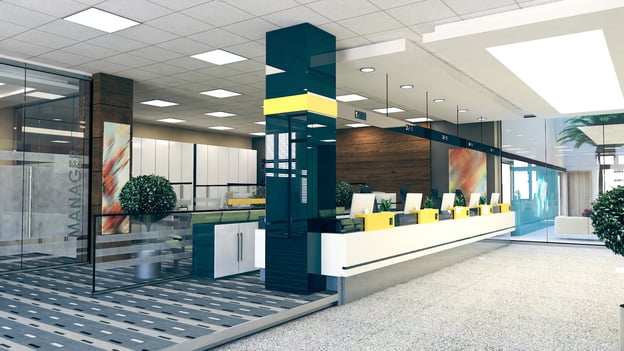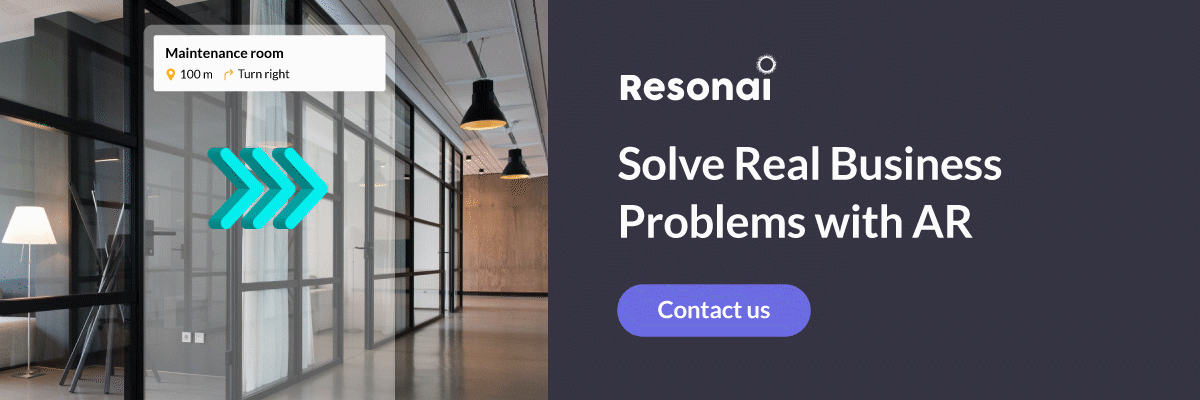4 Applications of Augmented Reality in Commercial Real Estate
From stakeholder buy-in to preventative maintenance, there are many benefits to integrating augmented reality into commercial real estate development.

In modern real estate, augmented reality can be as vital a foundation as stone. It lets developers more fully unlock the potential of a given space, addressing needs such as energy efficiency for recurring maintenance. Most importantly, it creates opportunities for enterprises to differentiate themselves from competitors and enhance the way occupants engage with their surroundings. It’s not surprising, then, to find studies suggesting 45% of investors prioritize implementing augmented reality in commercial real estate alongside adjacent technologies such as VR.
This article explores the high-level uses and benefits of augmented reality in commercial real estate, complete with practical examples that enterprises can leverage today.
Augmented reality in commercial real estate
Jump to a section...
Project design and stakeholder buy-in
Advanced maintenance solutions
Project design and stakeholder buy-in
The benefits of augmented reality in commercial real estate begin as early as the building design phase. AR technology allows users to visualize blueprints and other design documents as 3D models, complete with furniture and interior painting. This visualization technique is quicker than assembling physical models, allows for more detail than a 2D drawing, and is far easier to interpret at a glance than design documents.
Having this kind of perspective in the design stage is helpful for architects, but it also enhances investor buy-in. Stakeholders increasingly use 3D models to better understand the benefits of a given project. Potential tenants can tour a location during construction or well before it begins. Some investors even use AR apps or glasses to see how a finished building will eventually appear on-site, providing more insights into how it will fit among the surrounding lots.
Finally, AR tools can help designers and architects shift a building project into its construction. By integrating models with BIM software, multiple groups can coordinate construction efforts and better visualize their specific responsibilities.
Enhanced customer experiences
For many enterprises, AR within a commercial space is part of a customer experience, whether that means offering a service or making AR the product itself. This practice is most notable in retail but can occur in any industry — which is why developers should consider incorporating AR into building designs.
- Indoor wayfinding: In particularly large commercial facilities such as shopping malls, it can be challenging to find precisely what you need. Indoor wayfinding tech uses the same AR navigation capabilities that power GPS to provide directions to customers. Individual businesses may even use this feature to direct customers to specific products on store shelves.
- AR showroom floors: AR can be a valuable alternative for product viewing when individual items are not available on showroom floors. By installing a tablet or similar AR station, customers can search for products and visualize their appearance in a given space. Some brands are even experimenting with features like virtual clothes fittings. As a bonus, an additional button at this stage can let customers complete a checkout they can pick up on-site or send to their home address.
- AR experiences: There’s more to customer experiences than offering a product — sometimes, the experience is the main appeal. AR technologies can display unique artwork, gamified events, and much more. One fascinating example includes theme parks that offer AR-powered games and scavenger hunts using smartphone cameras to entertain visitors waiting in long lines.
Advanced maintenance solutions
Augmented reality can also provide maintenance solutions for most commercial spaces. In a traditional facility, businesses will call a repair crew once something goes wrong and then conduct a troubleshooting process to locate the problem. AR technology — such as Resonai’s Maintenance Manager — can streamline this process in several ways while ensuring the troubleshooting process is far more effective.
- Smart ticketing: With an intelligent system, building occupants can create maintenance requests that are automatically prioritized by location and urgently.
- Precise location tracking: Much like navigational wayfinding, maintenance location tracking lets technicians not only find a problem right away but where hidden items might be found — such as pipes or electrical systems.
- Process automation: Technicians need to be aware of how equipment operates and any previous maintenance tasks. They can quickly access this information by simply pointing a smartphone with an AR maintenance app towards the appropriate area.
- Predictive maintenance: The most cost-effective way to extend the lifespan of any asset or piece of equipment is taking action before it breaks down. Preventative maintenance systems can detect when items require an inspection or repairs, whether due to sensors, a machine learning analysis, or other processes. These techniques draw attention to assets before problems occur, maximizing operational effectiveness.
Want to know more about how contemporary facility managers are leveraging the power of AR to reduce overhead costs and improve key metrics like mean-time-to-repair? Download our industry report, The State of Augmented Reality in Facilities Management: 2021
Smart building capabilities
In a field like commercial real estate, smart buildings are the natural evolution of all the solutions discussed above. Smart buildings are facilities that use integrated technology systems to assist occupants with day-to-day operations and functions. They are possible by taking Internet of Things-enabled objects and connecting them to a digital twin, unifying their functions within a single interface. Whatever the industry, smart building functions can benefit from the integration of disparate systems such as telecommunications, facilities management, and any number of automated processes into a cohesive whole.
For stakeholders and facility managers in the commercial real estate space, smart buildings tend to maximize productivity and minimize costs. Some common examples include:
- Automated lighting: Leaving the lights on can be one of any facility’s most persistent energy uses. By integrating lighting systems into a smart building, the lights in each room can be set to timers or switched off when sensors determine a space isn’t in use.
- Remotely controlled safety systems: Any safety systems within the smart building integrate with the digital twin for remote monitoring and control. For example, a facility manager could activate fire alarms within a particular area while locking or unlocking any safety doors to facilitate evacuation procedures.
- Employee training: Smart buildings that leverage AR capabilities have immense potential as employee training centers. When new hires undergo onboarding, they can use customized AR apps that teach them how to locate and operate any specialized equipment as part of their role.
How Vera can help
When it comes to augmented reality, commercial real estate developers have more opportunities before them than ever. The question is not whether AR can help but whether it’s possible to implement these solutions now.
Rest assured, Resonai’s AR platform — Vera — can help you get started. Whether you’re designing a commercial facility or preparing a digital twin that powers a smart building, Vera’s system integration and real-time analytics offer the richest insights into any space. We also provide customized solutions that emphasize the highest-quality customer experience while reducing operational costs.
Ready to learn more? Get in touch with Resonai today and set up a free demonstration.
Subscribe to Our Newsletter!
Read More
5 Augmented Reality Real Estate Apps Helping Commercial Realtors Succeed
Closing a deal in the world of commercial real estate has historically been a lengthy and...
How Augmented Reality Home Decor Apps Are Powering Modern Design
Virtually everyone who’s ever owned a home has realized they chose the wrong color for the new...
5 Augmented Reality Real Estate Examples that Are Changing the Industry
From commercial real estate developers to home decor brands, the industry’s innovators have...

